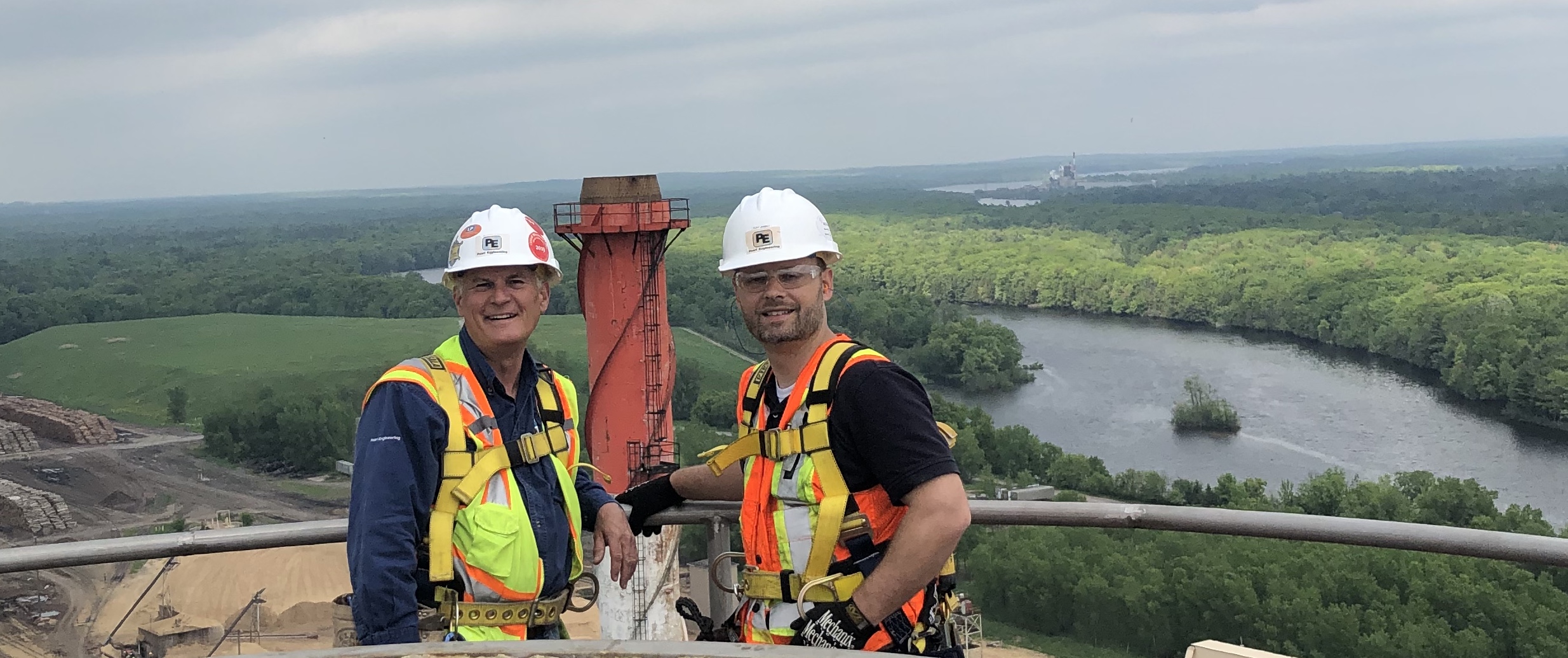
Jeff Pearl, left, in the field during a stack inspection.
Industrial smokestacks go through a lot during regular activity. Constantly pumping out steam vapor and exhaust exposes the interior of a smokestack to a tremendous amount of heat, gas, moisture, and even debris like sawdust. Over the course of months and years, all these factors can start adding up to quite a bit of wear and tear.
Faced with these elements, smokestacks are vulnerable to corrosion, which can cause structural damage and ultimately serious dangers like collapse. As such a crucial piece to production, plants can ill afford these kinds of damages, the investment it would require to replace them, and more so not meeting EPA regulations required for smokestacks.
That is where a stack inspection can provide a great deal of help for industrial plants! A stack inspection, one of the engineering services provided by Pearl Engineering, can provide detailed analysis and review of the condition of smokestacks and provide guidance and a plan for upgrades, improvements, or repairs to meet safety and quality.
How Stack Inspections are Done
Pearl Engineering president, Jeff Pearl, has performed stack inspections since 1983 all over the world. You could almost say he is more comfortable on a ladder or lift or the top of a smokestack than he is on flat earth!
“Unfortunately, when many finally call for a stack inspection it is already too late and holes, fires, or serious corrosion is already present. Ideally, stack inspections should be a consideration during routine maintenance.”
To perform a stack inspection, the team uses personnel lifts to use probes to measure plate thickness on the stack and look for visual signs of corrosion and damage during the process. Depending on the findings, the team will create reinforcement designs to use for repairs or a redesign plan for fixing the stacks if they are too far gone.
Designs and recommendations can include specifications for important items such as thickness, stiffness, sites for platforms and extensions, and OSHA violations.
For taller stacks, rigging, lifts, and platforms are required to be installed for the safety of the inspection team going up and down the great heights of a stack.
Different Stacks, Different Processes
Stacks comprised of different materials each require different evaluation tactics. Here is a quick rundown of common smokestack materials and some of the unique considerations.
Steel: The most common smokestack material, steel is extremely vulnerable to corrosion under the strain and elements of use. With the material making a stack essentially a lightning rod, one of the most important evaluations during an inspection is to ensure the stack is grounded. Visual and probe inspections check for corrosion and any loss in thickness.
Fiberglass: Fiberglass stacks are oftentimes smaller, but the material makes them vulnerable to softening under exposure to long years of sunlight and any chemicals the stack produces. To detect softness, a needle-like probe is used to puncture the exterior to take readings. Visual inspections look for “fiber blooms,” or patches where fiber is coming out.
Brick/Concrete: Chimneys of these materials are often times very large, and with a large stack comes large problems if damage is indeed determined. With no thickness readings methods available, inspections of brick or concrete smokestacks are purely visual. The team will look for cracks in brick or concrete, damage to mortar in brick chimneys, and corrosion of rebar in the concrete. These repairs are often extensive and may require serious work to get them back to the necessary condition.
Common OSHA Violations
Many smokestacks were designed and constructed prior to the establishment of OSHA standards, so safety is often a primary issue that is examined during a stack inspection.
The importance of safe climbing makes ladder missing slip-resistant rungs, monitoring platforms with no protective gates, and a lack of fall protection and netting some of the most common and egregious violations. These violations combined with the extreme heights of a stack inspection can have disastrous, and often deadly, consequences.
In need of a smokestack inspection to ensure the safety and compliance of your facilities? Let Jeff and the rest of the Pearl Engineering team provide you with a comprehensive inspection and report! Contact us to learn more.




